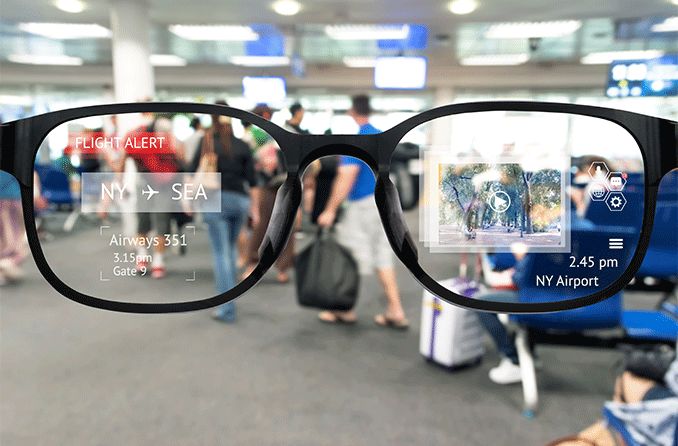In the realm of wearable technology, few innovations hold as much promise and potential as augmented reality (AR) glasses. These futuristic devices have the capability to overlay digital information and virtual content onto the real world, seamlessly blending the physical and digital realms to enhance our perception of reality. In this extensive exploration, we will delve deep into the world of augmented reality glasses, unraveling their underlying technology, examining their transformative applications, and exploring the exciting possibilities they hold for the future.
Understanding Augmented Reality (AR) Glasses:
Augmented reality glasses, also known as smart glasses or AR eyewear, are wearable devices that incorporate displays, sensors, and processing units to superimpose digital content onto the user’s field of view in real time. Unlike virtual reality (VR) headsets, which immerse users in entirely virtual environments, AR glasses enhance the user’s perception of the real world by overlaying computer-generated graphics, text, or images onto their surroundings.
Key Components of AR Glasses:
- Optical Display: The optical display is the primary component of AR glasses, responsible for projecting digital content onto the user’s field of view. This can take the form of transparent lenses, holographic displays, or miniature projectors integrated into the glasses frame.
- Sensors: AR glasses are equipped with a variety of sensors, including cameras, accelerometers, gyroscopes, and GPS modules, to capture real-world data and track the user’s movements and orientation. These sensors enable the glasses to understand the user’s environment and context, allowing for precise positioning and interaction with digital content.
- Processing Unit: The processing unit of AR glasses is responsible for running the necessary algorithms and software to generate and render digital content in real time. This includes tasks such as image recognition, spatial mapping, and gesture recognition, which require significant computational power and processing capabilities.
- Connectivity: AR glasses are typically equipped with wireless connectivity options, such as Wi-Fi, Bluetooth, or cellular data, allowing them to communicate with other devices, access online content, and synchronize data with cloud services. This connectivity enables real-time updates, remote control, and collaboration with other users or devices.
Transformative Applications of AR Glasses:
The potential applications of augmented reality glasses span a wide range of industries and sectors, including:
- Enterprise and Industry: In the enterprise sector, AR glasses have the potential to revolutionize workflows, training, and remote assistance in industries such as manufacturing, logistics, and field service. By providing hands-free access to digital information, instructions, and guidance, AR glasses enable workers to perform tasks more efficiently, accurately, and safely.
- Healthcare: In healthcare, AR glasses can enhance medical training, surgical navigation, and patient care by providing real-time access to medical imaging, patient records, and diagnostic information. Surgeons can use AR glasses to overlay anatomical structures onto the patient’s body during surgery, guiding their movements and improving surgical precision.
- Education and Training: AR glasses have the potential to transform education and training by creating immersive learning experiences that blend virtual and physical elements. Students can explore historical landmarks, conduct science experiments, or practice skills in simulated environments, enhancing their understanding and retention of complex concepts.
- Retail and Commerce: In the retail sector, AR glasses offer innovative shopping experiences, allowing customers to visualize products in their own environment before making a purchase. AR glasses can overlay virtual try-on experiences for clothing and accessories, provide product information and reviews, and enable interactive shopping experiences in-store or online.
- Entertainment and Gaming: AR glasses open up new possibilities for interactive entertainment and gaming experiences, enabling users to engage with digital content in the real world. Players can immerse themselves in augmented reality games, interact with virtual characters, and explore virtual worlds overlaid onto their physical surroundings.
Challenges and Considerations:
Despite their transformative potential, augmented reality glasses face several challenges and considerations that must be addressed:
- User Experience: Ensuring a seamless and intuitive user experience is essential for the widespread adoption of AR glasses. Designing comfortable, lightweight, and stylish glasses that provide clear, high-quality visuals without causing eye strain or discomfort is crucial for user acceptance.
- Privacy and Security: AR glasses raise concerns about privacy and security, particularly regarding the collection, processing, and sharing of personal data and location information. Safeguarding user privacy, protecting sensitive data, and implementing robust security measures are essential for building trust and mitigating risks.
- Content and Applications: Developing compelling content and applications for AR glasses requires collaboration between hardware manufacturers, software developers, and content creators. Creating immersive, engaging experiences that leverage the unique capabilities of AR glasses and resonate with users’ interests and needs is critical for driving adoption and retention.
- Regulatory and Legal Considerations: The deployment of AR glasses may be subject to regulatory requirements and legal considerations related to safety, privacy, and compliance. Ensuring compliance with relevant regulations, standards, and industry guidelines is essential for minimizing risks and liabilities associated with the use of AR glasses.
Conclusion:
In conclusion, augmented reality glasses represent a transformative evolution in wearable technology, offering immersive, interactive experiences that blur the boundaries between the physical and digital worlds. With their ability to overlay digital content onto the real world, AR glasses have the potential to revolutionize industries, empower users, and reshape the way we perceive and interact with our environment. As the technology continues to evolve and mature, it is essential to address the challenges and considerations surrounding AR glasses, ensuring that they deliver on their promise of enhancing our lives and unlocking new realms of possibility in the digital age.
